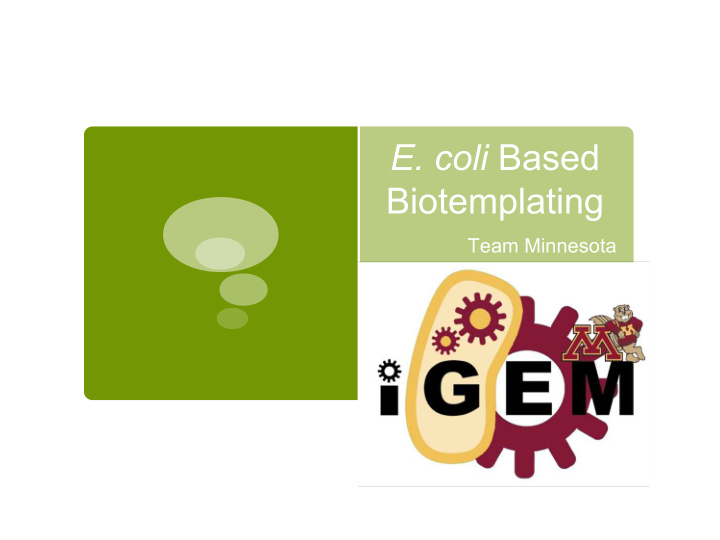



E. coli Based Biotemplating Team Minnesota
Biotemplating The production of complex, 3-D shapes using bacteria www.material.kemi.uu.se Biotemplating in nature: – Bone (hydroxyapatite) – Coccolith (calcite) – Coral (calcite) – Spicules (silica)
Applications Creation of biomimetic structures Polymerization of metals on the surface of cells Example of coral reef deterioration Bacterial cement Re-calcification of reefs Metal structures formed by E. coli recombinantly expressing silicatein 1 .
Variables: Control expression of precipitate Control contact of cells spie.org/x33929.xml?ArticleID=x33929 Benefits: Standard conditions Minimally toxic Less expensive www.nigels.com/cs516/
Background Information System Components
Biotemplating System Overview
Biotemplating System Overview
Biotemplating System Overview
Silicatein Isolated from marine sponge Suberites domuncula Protein responsible for spicule formation in sponges Nucleates silica polymerization and metal crystallization Can cause the formation of metal sheets when expressed in E. coli Obtained Silicatein gene from Korshev lab, Johannes Gutenberg- University, Mainz, Germany. Native silicatein filaments,Brutchey and Morse, 2008 2
Cell Surface Display System Automatically catalyze their own insertion and translocation across the outer membrane 2 parts: Passenger protein Carrier protein www.vaccineresistancemovement.org Current applications Vaccine development Antibody production Bioremediation www. genengnews.com
Ice Nucleation Protein Outer membrane protein from Pseudomonas syringae Catalyze formation of ice crystals 3 domains: N-terminal C-terminal Central domain Very stable Able to carry high molecular weight proteins Bloois, E. et al, 2011 1
Regulatory system Coliroid Light Induction System designed by University of Texas at Austin and UCSF iGEM team in 2004 www.partsregistry.org/Coliroid Control the expression of a target protein into specific 2D structure www.partsregistry.org/Coliroid
Strategy Methods & Process
INP-Silicatein Fusion Used Silicatein gene sent by Korshev lab Obtained a truncated version of INP (BBa_K265009 ) Fusion of INP and Silicatein Cloned into BioBrick vector pMCS5BB under lacP promoter
Silicatein Functional Assay p-methylaminophenol (Metol solution) R. K. Iler, 1979. 3 A. Rai, C. C. Perry, 2009. 4
Light Regulatory System Cloned into BioBrick vector pucBB-pBAD and pucBB-pTET Obtained PcyA gene from Synechocystis PCC6803 genomic DNA, Obtained ho1 from plasmid library Obtained chimera protein Cph8 from Voigt lab, UCSF
Biotemplating System Overview
Results What did we find?
Results Standard curve Silicatein Assay Standard Curve generated Linear correlation
Results Quantify total cell associated silicatein Cells with INP- silicatein Cells with only INP
Conclusions & Future Directions More Possibilities
Conclusions Fully functional surface silicatein expressed The coliroid light-sensitive system assembled In progress: Integrating regulatory system with INP-SIL fusion Production of specific shapes Direct evidence for surface display of INP- silicatein
Future Directions Use of IR/Heat-Shock induction system Use of urease or other nucleation proteins Formulation of media composition www.en.wikipedia.org/wiki/Laser Implement a NOT-gate
Acknowledgements Advisors: David Babson, Sarah Bloch, Tanhia Gonzales, Maureen Quin, Poonam Srivastava, Ian Windsor Instructors: Jeff Gralnick, Claudia Schmidt- Dannert Thank You To Our Sponsors!
Thank You! The End
References 1.) van Bloois E, Winter RT, Kolmar H, Fraaije MW. (2011) Decorating microbes: surface display of proteins on Escherichia coli. Trends in Biotechnology 29:79-86. 2.) Brutchey RL and Morse DE. (2008) Silicatein and the translation of its molecular mechanism of biosilicification into low temperature nanomaterial synthesis. American Chemical Scoiety . 108 (11): 4915-4934. 3.) Iler, RK. The Chemistry of Silica: Solubility, Polymerization, Colloid and Surface Properties, and Biochemistry. New York: Wiley, 1979. 4.) Rai A, Perry CC. (2009) Facile fabrication of uniform silica films with tunable physical properties using silicatein protein from sponges. Languir 26(6): 4152-4159.
Recommend
More recommend